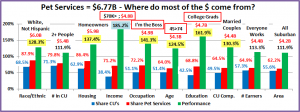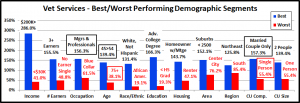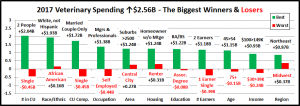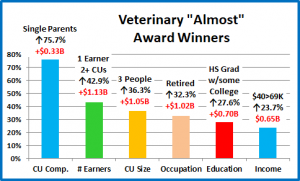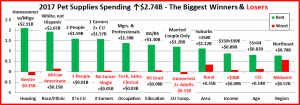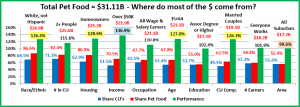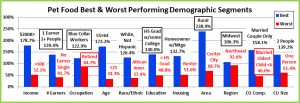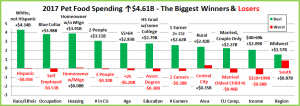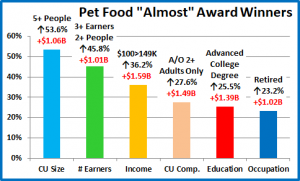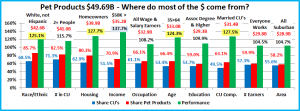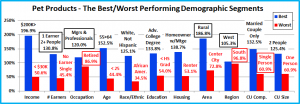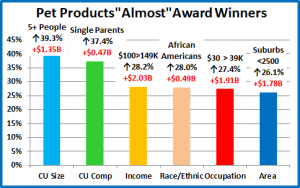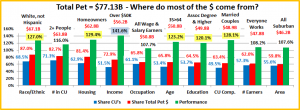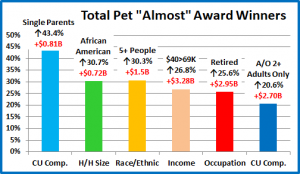Attending Global Pet Expo 2019? – It Has It All…and More! You Definitely Need a Plan!
The first Global Pet Expo (APPMA) occurred 61 years ago with 17 exhibitors in 30 booths. The industry and the show have both come a long way since then. In 2019 attendees will see and experience:
- 1145 separate exhibitor booths – with companies from the U.S. and 25 other countries – a Global experience!
- Over 357,000 square feet of booths (Plus 30,000 sq ft for the New Product Showcase) Global Pet Expo 2019 actually occupies more than 18 acres of prime Florida “real estate”.
- 1000 new items in the New Product Showcase plus 3000 more launched on the exhibit floor
- Sharing the aisles with 16,000+ attendees, more than 6000 “buyers”.
- The opportunity to choose from 34 different educational seminars – 49 hours of classes
- 5 miles of aisles – just to walk the exhibit floor
The show floor is open for 26 hours so let’s put this in perspective and…
“Do the Math!”
If you don’t attend any seminars, visit the New Product Showcase, stop to chat with anyone in the aisles or for food, a drink or to go to the bathroom and maintain a walking speed of 2.5 mph…
…you can spend about 1 minute and 15 seconds with each exhibitor!
You definitely need a plan!
Global Pet Expo definitely has it all… and more. Attendees will find the broadest selection of products and services while Exhibitors have the opportunity to reach a wide range of buyers across all retail channels.
First and foremost, Global is about Pet Products – Food, treats and a vast array of Supply categories. A regular flow of New Products is always critical to keep businesses and the whole industry strong and growing. Obviously, you must take the time to visit the New Product Showcase. You should also sign up for any relevant classes, network with other industry professionals and…walk the whole show. There are 3 times as many new products being “launched” on the show floor as there are on display in the New Product Showcase. Plus, 1 of every 3 exhibitors was not at Global 2018. Global is about gathering information and making decisions to improve your business – whether they are made on the spot or put on your “must do” list.
Every business can improve in terms of products. If you are a retailer, what sections of your store are not doing as well as you hoped and need a “facelift” or conversely, what areas are growing and need products to fill additional space? Category managers for distributors and retail chains may only be interested in targeted visits to exhibitors relevant to their “categories”. Representatives may be looking for new manufacturers…in specific product categories. Manufacturers could be looking to find distributors to handle their products or just looking to “check out” the competition. In regard to products, there is always something to see…for everyone!
And Global is the place to see it. It’s all there! With so much to see and do, Time is perhaps the most valuable commodity at the show. How do you make the most of your time on the show floor? Here’s an idea.
In 2014 I first designed a tool in Excel, the Super Search Exhibitor Visit Planner to make “working Global & SuperZoo easier and more productive for ALL attendees – retailers, distributors, reps, groomers, vets…even exhibitors. I have updated the data and produced a tool for every GPE and SuperZoo since then…including GPE 2019.
The “update” is not just exhibitor lists but also to the product category offerings for every exhibitor. I reviewed every exhibitor profile on the show site but I also visited over 1100 websites and conducted separate internet searches to “validate” the product offerings. It is not 100% accurate, but it is close.
What does the SuperSearch do?…It searches for and produces a list of Exhibitors by product categories.
- From the simplest – “give me a list that I can look at on my phone or tablet in either Booth # order or alphabetically”
- To the most complex…”can do a simultaneous search for multiple specific product categories, allowing you to personally narrow down the initial results and see the “final” alphabetically or by booth number. The GPE Super Search Exhibitor Visit Planner does both…and more…and does it quickly! Take a look at the Quick Start Guide. You will see that it looks complex but is really quite simple.
GPE 2019 Super Search Exhibitor Visit Planner – Quick Start Guide
First: When you download the Excel file, Remember to Enable Editing & Macros!
The GPE Super Search Exhibitor visit planner is designed to make your time on the show floor more efficient and more productive. With the Super Search you can conduct up to 5 separate and distinct product category searches simultaneously with consolidated results produced in booth # order to facilitate your “journey”. There are detailed instructions for reference and to help you understand the nuances of the tool. However, it is really very simple so let’s get started. (Note: No changes in instructions from 2018) Here is the Dashboard where you set up your searches. ↓
On the dashboard, the first things to note are the numerous category columns. There are 5 different floor sections, 11 different Exhibitor or Animal Types and 32 Dog and/or Cat Product categories. You can search exhibitors for any combination of these.
Let’s take a specific example running 3 simultaneous searches for several Dog/Cat categories:
- Toys
- Treats
- Catnip & Litter (Must sell both)
Now referring to the Dashboard, let’s take it by the numbers:
#1. This column is where you activate each search. Type in a “Y” (Cells C3>C7 will auto-capitalize) This search “line” becomes active.(cell turns green) In our example we are running 3 searches so we have 3 green “Y”‘s.
#2. Now we enter a 1 in the correct column for each search line. Search Line 1: Toys; Search Line 2: Treats.
#3. In Search Line 3 we want exhibitors that sell both Catnip and Litter so we put a 1 in both of these columns.
#4. Now we just “click” the Execute Search Button. The searches are done simultaneously and the results combined into a single list in alphabetical order.
#5. If you would like to view the list in Booth # order, just click the Booth # Sort.
#6. You can switch the list back to an alpha view by clicking the Alpha Sort Button.
#7. To Clear all your search categories and start a new search, Click the Clear Criteria Button. Then click Execute (#4) again and you will be back to the full list
Note: Any Search Line with a Y and no 1’s in any column will always deliver the entire list regardless of what is selected in other lines. Change the Y back to an N in unused search lines. Now a sample of the results:
- Company A has Toys Only
- Company B has Dog Treats Only and is also a 1st Time Exhibitor at GPE
- Company C is on the list for Treats and also has Catnip, but no Litter. This is not unusual as Catnip is often a Treat
- Company D has Treats & Toys.
- Company E has both Catnip and Litter and in fact, actually has it all!
Note: The Super Search highlights your search categories so you know “why you are there”. However, it also shows all categories that are available. Some might “pique” your interest while you are visiting the booth.
You can review the exhibitors alphabetically then put the list in Booth # order to make it easier to “work”. The Super Search also allows you to “cut down” the list during your review. (Pg 2; Point #11 – “U Pick ‘em” in Detailed Instructions) But First, I suggest that you “play” with the Super Search to get a “feel” for the tool, and then review the Detailed Instructions. With your “play” experience, the detailed instructions will become a “quick read” and a valuable reference. You will soon be “up to speed” on the full capabilities of Super Search.
Ready to Start Planning?
Use the links below to download the Super Search Tool (Be Sure to Enable Editing/Macros/Content if asked by your computer), the Quick Start Guide and the Detailed Instructions. Then GET STARTED!
[button link=”https://petbusinessprofessor.com/wp-content/uploads/2019/02/GPE-2019-QuickStartGuideSUPERSEARCHExhibitorVisitPlanner.pdf” type=”icon” newwindow=”yes”] Download Quick Start Guide (PDF)[/button]
(To save the PDF to your computer Right Click the download link and select “Save Link As…”)
[button link=”https://petbusinessprofessor.com/wp-content/uploads/2019/02/2019-GPE-SUPERSEARCH-ExhibitorVisitPlannerDETAILED-Instructions-2-21.pdf” type=”icon” newwindow=”yes”] Download Detailed Instructions (PDF)[/button]
(To save the PDF to your computer Right Click the download link and select “Save Link As…”)
[button link=”https://petbusinessprofessor.com/wp-content/uploads/2019/03/GPE2019-SuperSearch-FINAL-.xlsm” type=”icon” newwindow=”no”] Download GPE 2019 Super Search FINAL (Excel)[/button]
(For the Excel file to work on your computer, be sure to enable macros/editing/content if asked.)
NOTE: The SuperSearch has been finalized with changes since 3-11. New exhibitors added between 2/25 and 3/4 are still highlighted in light blue. New exhibitors added between 3/4 and 3/11 are still highlighted in pink. The exhibitors added since 3/11 are highlighted in yellow.






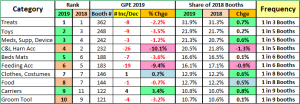
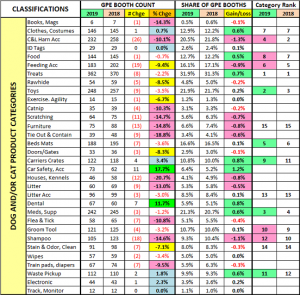



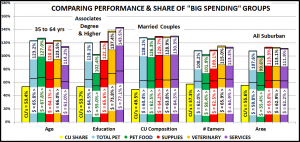






 = Flipped from 1st/Last in 2016 or vice versa
= Flipped from 1st/Last in 2016 or vice versa






